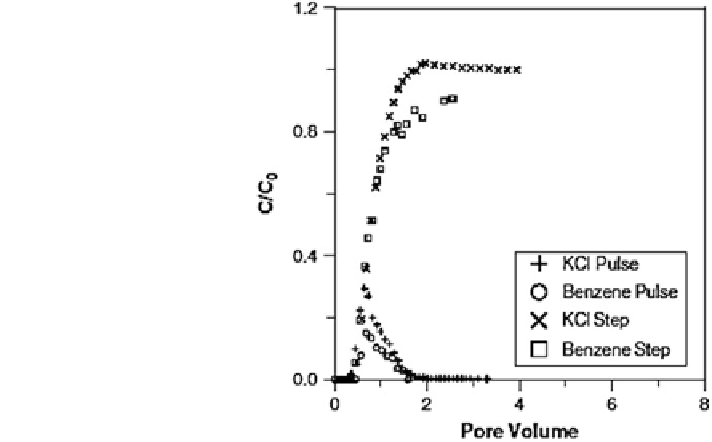Geoscience Reference
In-Depth Information
Fig. 17.25 Breakthrough
curves of KCl and benzene
tracers injected with square
pulse and step methods into
sandy materials (Baek et al.
2003
). Reprinted from Baek
et al. (
2003
). Copyright 2003
with permission of John
Wiley and Sons
as ferrous iron and methane, indicates the potential extent of anaerobic biodeg-
radation. However, this type of attenuation may lead only to a partial decrease in
petroleum hydrocarbon presence in contaminated groundwater. Suarez and Rifai
(
2002
) evaluated the natural attenuation of a polluted groundwater situated under
an industrial facility in a coastal area of the United States. Between 1950 and 1985,
the facility produced ethylene, diethylene, and ethylene derivates using raw
materials such as crude and refined BTEX and naphthalene. In addition to daily
contamination by facility wastes, an accidental pipe rupture in 1977 caused a spill
of about 300,000 gallons of BTEX, containing 70 % benzene. This resulted in a
petroleum hydrocarbon plume in the groundwater, with maximum benzene and
xylene concentrations of 1,780 and 200 mg/L, respectively, in 1979. Due to nat-
ural attenuation, the maximum benzene concentration declined to 580 mg/L by
1996 (Fig.
17.26
), while that of xylene reached 57 mg/L (Fig.
17.27
). In spite of
uncertainties associated with the site hydrology, analyses of mass flux proved to be
a good tool for assessing the contribution of biodegradation to natural attenuation.
The study showed that the total loss of BTEX attributed to biodegradation was
100,000 pounds; from source well data (half-life of 15 years), an attenuation rate
of 0.0001 d
-1
was derived. At this rate of natural attenuation, complete decon-
tamination in the petroleum hydrocarbon polluted area will occur only after about
250 years (Suarez and Rifai
2002
). Under such conditions, the groundwater con-
tamination may be considered as irreversible.
Another example of microbiological influence on natural attenuation of petro-
leum hydrocarbons is found in a monitoring study in a shallow, unconfined aquifer
located in Williamtown, Australia (Naidu et al.
2012
). The contamination source
was a fuel facility, which caused a contamination plume about 30 years ago.
Groundwater sampling and analysis revealed that naphthalene and xylene are the

